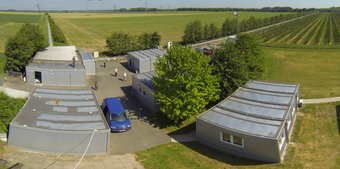Gravitational wave detector in Hannover tests holographic Universe
Are we living in a holographic universe?
Are we living in a holographic Universe? Are space and time grainy? Is there quantum noise in spacetime? American physicist Craig Hogan is convinced that he has found proof in the data of the German-British gravitational wave detector GEO600 – and that his ideas could explain mysterious noise in the detector data which has not been explained so far. New experiments in the coming months will yield more evidence about Craig Hogan’s assumptions.
To test the theory of holographic noise, the frequency of GEO600’s maximum sensitivity will be shifted towards ever higher frequencies. The frequency of maximum sensitivity is the tone that the detector can hear best. It is normally adjusted to offer the best chance for hearing exploding stars or merging black holes.
Even if it turns out that the mysterious noise is the same at high frequencies as at the lower ones, this will not constitute proof for Hogan’s hypothesis. It would, however, provide a strong motivation for further study. The sensitivity of GEO600 will then be significantly improved by using ‘squeezed vacuum’ and by the installation of a mode filter in a new vacuum chamber. The technology of ‘squeezed vacuum’ was particularly refined in Hannover and would be used in a gravitational wave detector for the first time.
“We are very eager to find out what we can learn about the possible holographic noise over the course of the coming year”, says Prof. Dr. Karsten Danzmann, director of the Hannover Albert Einstein Institute. “GEO600 is the only experiment in the world able to test this controversial theory at this time. Unlike the other large laser interferometers, GEO600 reacts particularly sensitively to lateral movement of the beam splitter because it is constructed using the principle of signal recycling. Normally this is inconvenient, but we need the signal recycling to compensate for the shorter arm lengths compared to other detectors. The holographic noise, however, produces exactly such a lateral signal and so the disadvantage becomes an advantage in this case. You could say that this has placed us in the very centre of a tornado in fundamental research!”
Searching for the graininess of space
The smallest possible fraction of distance is called the “Planck length” by physicists. Its value is 1.6 x 10-35 m – this is impossible to measure by itself. The established physical theories cease to function at this scale. GEO600 scientists are testing a theory by US physicist Craig Hogan, who is convinced he can hear the noise of space quanta in the data of the gravitational wave detector GEO600. Hogan suggests that the mirrors in an interferometer wander relative to one another in very rapid steps of the tiny Planck amount, that accumulate during the time of a measurement into something as large as a gravitational wave would produce. Hogan and the GEO600 scientists are following up the question whether a certain ‘noise signal’ in the data recorded by the detector can be traced back to the graininess of space and time.
Craig Hogan
is the director of the Center for Particle Astrophysics at the Fermi National Accelerator Laboratory, as well as professor for astronomy and astrophysics at the University of Chicago. He was part of the team of scientists who co-discovered dark energy in 1998.
GEO600

Because of its innovative and reliable technology, GEO600 has gained an excellent worldwide reputation and is considered a think-tank for international gravitational wave observation. It was here that the most modern lasers in the world were developed which are being used in all the gravitational wave observatories in the world today. Researchers at GEO600 are taking technology a step further with ‘squeezed vacuum’. This technology is designated for use in the third generation of gravitational wave detectors. GEO600 is a joint project of scientists of the Max Planck Institute for Gravitational Physics (Albert Einstein Institute, or AEI), Leibniz Universität Hannover, Cardiff University, the University of Glasgow and the University of Birmingham. It is funded jointly by the Max Planck Society in Germany and the Science and Technology Facilities Council in UK.
The Centre for Gravitational Physics, Albert Einstein Institute (AEI) Hannover
At the Centre for Gravitational Physics, the Max Planck Society and Leibniz Universität Hannover jointly carry out experimental gravitational wave research. This includes basic research as well as applied research in the fields of laser physics, vacuum technology, vibration isolation in addition to classical optics and quantum optics. Other research focuses on the implementation of data analysis algorithms for different sources of gravitational waves. Together with the theoretical departments of the Max Planck Institute for Gravitational Physics in Potsdam, the Albert Einstein Institute constitutes a unique research centre for gravitational physics which covers all aspects of this field. Together with British research institutes, the Centre for Gravitational Physics runs the gravitational wave detector GEO600 in Ruthe, near Hanover. Scientists of the institute are also leading participants in LISA (Laser Interferometer Space Antenna), the planned gravitational wave detector in space. This joint project by NASA and ESA will measure gravitational waves in space from 2018 on, and will thus “listen” into deep space further than ever possible before.
The Cluster of Excellence QUEST, Hannover
AEI Hannover is a partner in the Excellence-Cluster QUEST which is funded by the ‘Initiative for Excellence’ of the federal German government and the federal states of Germany. QUEST (Centre for Quantum Engineering and Space-Time Research) will focus on research on quantum engineering and spacetime and explore the underlying physics and develop innovative methods for new applications. QUEST’s activities will promote four core aspects of current research: quantum engineering, quantum sensors, space-time physics and future technologies.
